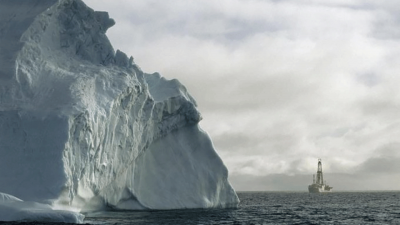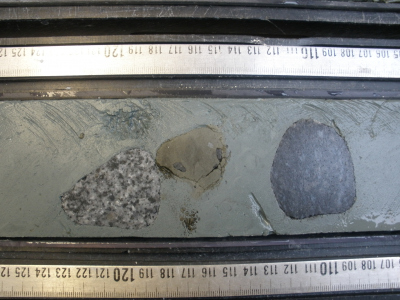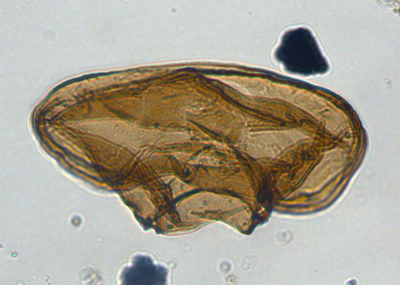Page path:
- Home
- Discover
- Media Releases
- Media Releases 2013
- 19-04-2013 Fossils provide insight into origins...
Fossils provide insight into origins of Antarctic ecosystem
In 2010 the Integrated Ocean Drilling Program (IODP) took, for the first time, long complete sediment cores from the seafloor along the Antarctic margin south of Australia. Previous studies on these sediment cores demonstrated that subtropical plants covered Antarctica about 53 million years ago. The current study focuses on a time period 20 million years later. During these 20 million years, the climate gradually cooled, until large ice sheets appeared on Antarctica 33.5 million years ago.
The researchers studied fossils of single-celled dinoflagellates in the sediment cores. They found that when Antarctica was sub-tropical and ice-free, the seas were inhabited by a diverse array of dinoflagellates that are characteristic for relatively warm climates. However, from the moment that the ice cap came into existence the diversity demised and only species are found that are at present associated with sea-ice environments around Antarctica.
"Today, the seas around Antarctica play a critical role in the oceanic food web. Strong algal blooms only occur in summer, when the sea-ice melts. These blooms are a key food-source for both small single-cell organisms such as certain species of dinoflagellates and for larger organisms" explains first author Sander Houben of Utrecht University.
"We believe that the sudden change in the ecosystem of the Antarctic waters as indicated by the sudden appearance and dominance of these dinoflagellate species, was connected with the development of sea-ice conditions", continues Houben. "This was not only critical for climate, but also for biology. Larger sea animals probably adapted their diet because the algal growth season became shorter and more intense. We therefore believe that it is no coincidence that the evolution of modern whales and penguins approximately corresponds with the emergence of the ice sheets."
These results stress that major climate change is often accompanied by rapid biological evolution.
Publication
A.J.P. Houben, P.K. Bijl, J. Pross, S.M. Bohaty, S. Passchier, C.E. Stickley, U. Rӧhl, S. Sugisaki, L. Tauxe, T. van de Flierdt, M. Olney, F. Sangiorgi, A. Sluijs, C. Escutia, H. Brinkhuis and the IODP Expedition 319 Scientists: Reorganization of Southern Ocean Plankton Ecosystem at the Onset of Antarctic Glaciation, 19 April 2013 in Science
7 expedition videos can be found here.
More information/images/interviews:
The researchers studied fossils of single-celled dinoflagellates in the sediment cores. They found that when Antarctica was sub-tropical and ice-free, the seas were inhabited by a diverse array of dinoflagellates that are characteristic for relatively warm climates. However, from the moment that the ice cap came into existence the diversity demised and only species are found that are at present associated with sea-ice environments around Antarctica.
"Today, the seas around Antarctica play a critical role in the oceanic food web. Strong algal blooms only occur in summer, when the sea-ice melts. These blooms are a key food-source for both small single-cell organisms such as certain species of dinoflagellates and for larger organisms" explains first author Sander Houben of Utrecht University.
"We believe that the sudden change in the ecosystem of the Antarctic waters as indicated by the sudden appearance and dominance of these dinoflagellate species, was connected with the development of sea-ice conditions", continues Houben. "This was not only critical for climate, but also for biology. Larger sea animals probably adapted their diet because the algal growth season became shorter and more intense. We therefore believe that it is no coincidence that the evolution of modern whales and penguins approximately corresponds with the emergence of the ice sheets."
These results stress that major climate change is often accompanied by rapid biological evolution.
Publication
A.J.P. Houben, P.K. Bijl, J. Pross, S.M. Bohaty, S. Passchier, C.E. Stickley, U. Rӧhl, S. Sugisaki, L. Tauxe, T. van de Flierdt, M. Olney, F. Sangiorgi, A. Sluijs, C. Escutia, H. Brinkhuis and the IODP Expedition 319 Scientists: Reorganization of Southern Ocean Plankton Ecosystem at the Onset of Antarctic Glaciation, 19 April 2013 in Science
7 expedition videos can be found here.
More information/images/interviews:





